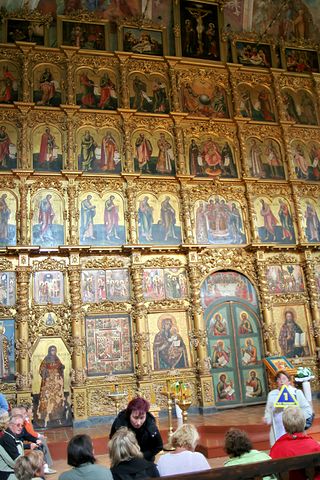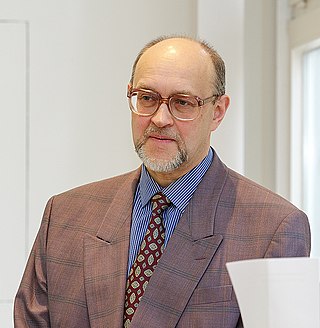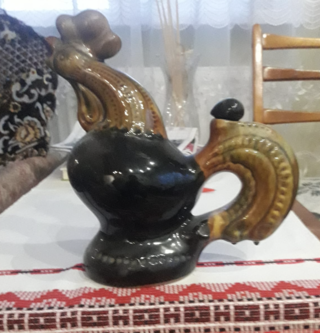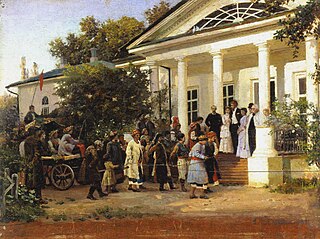
The Boykos, or simply Highlanders, are an ethnolinguistic group located in the Carpathian Mountains of Ukraine, Slovakia, Hungary, and Poland. Along with the neighbouring Lemkos and Hutsuls, the Boykos are considered a sub-group of Ukrainians and speak a dialect of Ukrainian language. Within Ukraine the Boykos and other Rusyns are seen as a sub-group of ethnic Ukrainians Boykos differ from their neighbors in dialect, dress, folk architecture, and customs.

The Byzantine Rite, also known as the Greek Rite or the Rite of Constantinople, is a liturgical rite that is identified with the wide range of cultural, devotional, and canonical practices that developed in the Eastern Christian church of Constantinople.

The Ukrainian Lutheran Church, formerly called the Ukrainian Evangelical Church of the Augsburg Confession, is a Byzantine Rite Lutheran Church based in Ukraine. The Eastern Christian denomination consists of 25 congregations within Ukraine, serving over 2,500 members and runs Saint Sophia Ukrainian Lutheran Theological Seminary in Ternopil in Western Ukraine.

The Luther rose or Luther seal is a widely recognized symbol for Lutheranism. It was the seal that was designed for Martin Luther at the behest of John Frederick of Saxony in 1530, while Luther was staying at the Coburg Fortress during the Diet of Augsburg. Lazarus Spengler, to whom Luther wrote his interpretation below, sent Luther a drawing of this seal. Luther saw it as a compendium or expression of his theology and faith, which he used to authorize his correspondence. Luther informed Philipp Melanchthon on 15 September 1530, that the Prince had personally visited him in the Coburg fortress and presented him with a signet ring, presumably displaying the seal.

The Orthodox Church of Ukraine, also called the Ukrainian Orthodox Church, is a partially recognized Eastern Orthodox Church in Ukraine. It was granted autocephaly by the Ecumenical Patriarch of Constantinople on 6 January 2019.

The Russo-Ukrainian War gave rise to a civil volunteer movement which provides diverse support to Ukrainian soldiers fighting in Donetsk and Luhansk oblasts.

Volodymyr Potulnytskyi is a Ukrainian historian who specializes in European medieval history, Ukrainian political science, intellectual history, historiosophy and historiography of Eastern Europe.

Reasonable Force is a Ukrainian political party, founded on 22 January 2016. It is led by Alexander Solovyov. The party consists of 26 regional and more than 600 local organizations. The members of the party are more than 20,000 citizens of Ukraine. It is represented in 16 local councils based on the results of the elections, held in December 2016 and April 2017.
Yaryzhka or Orthography of Slobozhanshchyna is the name of the pre-revolutionary orthography used to write and print works in the Ukrainian language in the Russian Empire. Yaryzhka included all the letters that were part of the Russian Cyrillic alphabet of the pre-revolutionary period: ы, ъ, and so on.
Dokiya Kuzmivna Humenna was a Ukrainian and Ukrainian American writer, one of the most prolific authors of the literary Ukrainian diaspora.
Arts of Ukraine is a collection of all works of art created during the entire history of Ukraine's development.
Shashkevychivka, Spelling of the Mermaid of the Dniester, and also Spelling of the Ruthenian Triad is the first phonetic spelling system for the Ukrainian language based on the adapted Cyrillic script, used by the Ruthenian Triad in the almanac "Mermaid of the Dniester" (1837). Markiian Shashkevych used to be considered the author of the spelling system used in "Mermaid of the Dniester", which is why it is called Orthography of Shashkevych or Shashkevychivka. The use of the phonetic principle of spelling was motivated in the foreword by Markiian Shashkevych by the fact that «we need to know what the true face is in the present language; because of this we follow the rule: „write as you hear, and read as you see“».

Vasylkiv maiolica rooster is a replicated decorative piece produced by the maiolica factory in Vasylkiv, created by Valerii Protoriev and Nadiia Protorieva. It became a symbol of resilience during the Russian invasion of Ukraine after a photo of one of the houses in Borodianka went viral: despite the flat being almost completely destroyed, a kitchen cabinet on the wall survived. Upon closer inspection, a decorative maiolica rooster was noticed atop it.

alerts.in.ua is an online service that visualizes information about air alerts and other threats on the map of Ukraine.

Traditional Ukrainian wedding – is a wedding in Ukrainian folk everyday life – a complex mixture of rites of different days, in which elements of the ancestral exogamic era, Greek-Byzantine religious-mystical influences and newer Ukrainian ones are distinguished.

Akim Alfadovych Galimov is a Ukrainian journalist, screenwriter, producer, author of documentary and historical projects.
Viacheslav Mykolaiovych Minka was a Ukrainian military pilot, Major of the 40th Tactical Aviation Brigade of the Air Force of the Armed Forces of Ukraine, a participant in the Russian-Ukrainian war. Hero of Ukraine.
The All-Ukrainian mental health program "How are you?" is an initiative aimed at building a quality system of providing services in the field of psychosocial support and developing a culture of mental health care. The initiative was launched by Olena Zelenska, the First Lady of Ukraine, in May 2022.
Oleksandr Volodymyrovych Petrovskyi is a Ukrainian public person, entrepreneur, philanthropist. Delegate of the Unification council of the Eastern Orthodox churches of Ukraine in 2018.

A law of Ukraine titled On the Protection of the Constitutional Order in the Field of Activities of Religious Organizations was adopted by the Verkhovna Rada of Ukraine on August 20, 2024. The law was adopted by 265 votes of people's deputies, while 29 voted against it, 4 abstained, and 23 did not vote.














